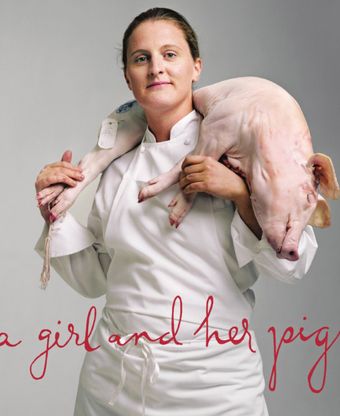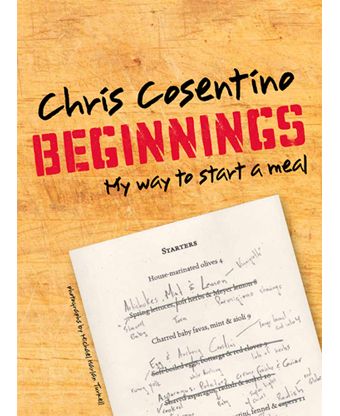Cosentino and Bloomfield are both known for muscular, meaty cooking that elevates all the lesser bits of the animal. In their new books, A Girl and Her Pig (Bloomfield) and Beginnings: My Way to Start a Meal (Cosentino), both pay tribute to Italian culinary traditions, filtered through personal experience and enthusiasms. And that’s basically where the similarities between these books end.
For one, Cosentino’s is explicitly not a full download of the chef’s worldview. It is a book of starters. Chapters and recipes are arranged by seasons, bookended by brief, not terribly useful primers on salumi and cheese. (On buying cheese: “If I like it, I buy it. It’s that simple!”) Vegetables are emphasized, a conscious contrast to the offal he’s known for. A gutsier title would have been A Shitload of Salads, but I can see how a marketing department might reject that. One complaint about the generally appetite-encouraging photography: page 72. The visual deal-killer for me here is the cheffly schmear, the poo-poo streak of blackened onion charcoal wiped across the plate. The skidmark style of saucing has gotten really old in restaurants and just has no place in a book for civilians.
Bloomfield’s book is, by contrast, a more enveloping affair. It is intimate and roaming. Growing up in blighted Birmingham, she meant to be a cop, we learn, but she got pissed at the pub and turned her application in too late. Cooking was a runner-up career choice, and lucky for us. There are sweet asides about her time at London’s River Cafe and a nice little chapter called “My Fussy Recipes” in which we are smartly instructed on the art and purpose of blanching and peeling tomatoes. There isn’t a ton of photography but what’s there is evocative and in some cases instructive: a two-page spread usefully illustrates the precise consistency of various sauces (lemon-caper, romesco, salsa verde, and more).
Onto the cooking! It’s impossible to really compare a book of first courses to a book of bits of everything. Seeking parity, I decide to cook complementary dishes from each. This (at the time) being fall, I’m pretty much morally obligated to limit myself to Cosentino’s "Fall" chapter. This presents some issues. For instance, 14.2% of his fall recipes involve sprigs of Douglas fir, (okay, that’s only two recipes but I’m trying to be scientific here), and I’m not in the mood for Christmas tree. I rule out trying something called “Dirty Vegetables” on the basis that it is called “Dirty Vegetables.” The first recipe in the chapter is a drink: the Bloody Roman. I’m halfway through the lengthy shopping list—heirloom tomatoes, Red Boat fish sauce, Aleppo pepper, check, check, check—before I realize there's no vodka indicated. There is Anchor Steam beer and oysters. This is less a bloody variant, more a drinkable cioppino or maybe a seafood michelada. I track down Aleppo pepper at Dean & Deluca, I shuck the briny oysters myself, I pass my late-season heirlooms through the food mill. I do it all, short of investing in chile thread garnish. The result: beer and tomato juice are not, for me, ideal companions. My oysters do not float atop the drink as they do in the photo and I find myself searching the depths of the glass for them, wishing this was a tiny little shooter instead of an expensive pint.
Continuing with seafood and tomatoes, I turn to Bloomfield’s chapter “Meat Without Feet” and select a slow-cooked garlicky stew of octopus, tomato and butter beans. I make many mistakes. I use old beans and don’t soak them. I buy baby octopi that emit none of the octopus broth Bloomfield promises. Still, the whole thing works beautifully and is dead easy. I whip a batch of her Green Goddess dressing together, add the suggested bright green dollops to the stew and I am a hero to my dinner guests. I want to give a high-five, times eight, to my forgotten friend, the forgiving, chewy-crisp octopus.
It’s a tighter race when we come to the Meatball Showdown. Cosentino’s Pork & Porcini Polpettini in a mushroom broth are fluffy but rich and remind me of canederli dumplings I had in the Dolomites. They too are easy, relatively fool-proof, and utterly satisfying but I have a quibble here too: an ingredient (Porcini Brodo) that leads me to a recipe in the back that itself contains two more recipes (Chicken and Pork Stock) is one soup step too many.
Bloomfield’s Lamb Meatballs with Yogurt, Eggs and Mint is a more complex assemblage but worth the effort of grinding your own lamb shoulder—especially if you don’t, as I did, make the near-fatal mistakes of overworking the meat and idiotically substituting panko for fresh breadcrumbs which result in a too-tight meatball. Still, the thing tasted good: the lamb and sweet spice of the tomato sauce giving ballast to the creamy contrast of yogurt and runny eggs added at the end. Finishing it with mint and cilantro is ingeniously elevating.
I try a couple of salads from Cosentino’s book because, as I said, there are a shitload of salads up in here. Apple, Dandelion & Hazelnuts didn’t do much for me. Occasionally you’d get all the right bits in your mouth at once and there was a certain harmony to it, but the apple cider vinaigrette tasted muddled and limp to me and I resented making a cup and a half of it for a salad that only serves six. I strayed into the "Winter" chapter for a salad of Treviso, Pomegranate & Pistachios. Visually arresting, it was better seen than savored; it was a promising notion that, with a little more tweaking, might grow up into a good idea.
The morning after I found myself returning to Bloomfield’s book, yearning for pig’s ear salad and eton mess. Here’s the basic thing: one of these cookbooks vibrated on my personal frequency and one didn’t. I’m sure Cosentino could make all these recipes sing, but I didn’t have great luck with them and didn’t feel drawn back to them.
For breakfast I made Bloomfield’s Baked Eggs with Anchovies and Cream. I liked her way with languid language (“chop the garlic with the rosemary until the mixture looks a bit like blue cheese”) and I liked the result even better: buttery, homey, salty, satisfying. I scraped the ramekin with crunchy grilled bread. The Girl and Her Pig makes me want to try pretty much everything between its covers -- and that’s why it handily dominated this showdown between worthy competitors.



36 Comments
Mr. Sachs' pointless snark misses the mark and seems to suggest he is judging without even trying the recipe ("14.2% of his fall recipes involve sprigs of Douglas fir...and I’m not in the mood for Christmas tree." That's not funny or witty and seems like Mr. Sachs is just pointlessly shitting on Chef Cosentino). Flaccid attempts at humor aside, Mr. Sachs, from the opening paragraph, clearly states that these are not similar books.
So why the comparison? What is the value of this bracketed tournament? What is the point?
This isn't how people cook from books. We don't pit them against each other. We include them in our lives at the moments we need them most. There are times when Chef's Bloomfield's recipes speak to us, and there are times when we will want Chef Cosentino's Shitload of Salads.
What we don't need, however, is for food52 to continue on with a shitload of pointless competition.
P.S. Thank you, @nightkitchen. You summed it up beautifully.
I have followed your tournament since last year and a couple of my friends are judges for it. I'm not as ignorant as I might appear. Stupid, sure. But not ignorant.
I love what you wrote about how you select books for the tournament. Really. Could you possibly explain to me how that love and celebration of an author's book is present in this review for Chef Cosentino? Was it the skidmark comment? Or the description of the primer that wasn't terribly useful? Something tells me the team at his publishing house weren't thrilled with the way you all show your love. I'd hate to see what you encourage from your reviewers when you hate a book.
I'm also confused as to your support of the reviewer's responsibility to judge a book fairly, but I'm not supposed to judge the fairness of a review or the appropriateness of your tournament. And if I do either of those, I'm mean.
With the risk of being called mean, let's apply your explanation of why you do tournament (which really is great) to this review. It utterly fails to live up to what you state is the intention of the tournament. Perhaps that's more the responsibility of an editor to help shape and guide. Was there an editor on this? Is this piece really what the tournament is all about?
But I'm mean. And stupid.
I'll just trust your intentions from now on and not judge what you actually publish.